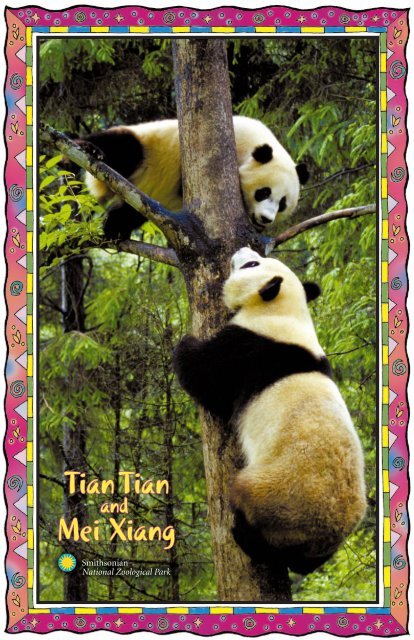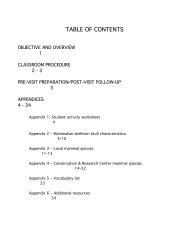Panda Brochure.rev3 - National Zoo
Panda Brochure.rev3 - National Zoo
Panda Brochure.rev3 - National Zoo
Create successful ePaper yourself
Turn your PDF publications into a flip-book with our unique Google optimized e-Paper software.
Tracking Giant <strong>Panda</strong>s<br />
Take an adventure into the forests<br />
of China in search of giant pandas.<br />
First read the field notes to find out what lives in these<br />
forests. Then look at the numbered clues on the map.<br />
Use the animal signs to identify what’s there, like field<br />
scientists do. Write the clue number next to the<br />
correct animal field note. Can you find all three giant<br />
panda clues? What other animal signs can you find?<br />
Asiatic black bear<br />
Makes a resting<br />
spot on the ground<br />
out of leaves.<br />
Takin<br />
Related to cows;<br />
lives in herds.<br />
Golden monkey<br />
Travels in large<br />
groups through leafy<br />
treetops, calling<br />
when alarmed.<br />
2<br />
Tree with scratches<br />
and a dark smear<br />
3<br />
Hairy droppings<br />
Start here<br />
1<br />
Call from<br />
the bushes<br />
4<br />
Small oval<br />
droppings<br />
Good tracking! Lots of animals<br />
share a giant panda’s home!
8<br />
Leafy nest on<br />
the ground<br />
9<br />
Tiny round<br />
droppings<br />
10<br />
Giant panda<br />
Large oval droppings<br />
with bamboo bits<br />
• Peels bamboo before eating,<br />
scattering bits all around.<br />
• Hardly digests food, so large,<br />
potato-shaped droppings contain<br />
bamboo pieces.<br />
• Marks trees by scratching bark<br />
and scent-marking (leaving a<br />
dark, sticky substance).<br />
5<br />
Bamboo stumps<br />
and bits<br />
7<br />
Loud calls and<br />
rustling leaves<br />
6<br />
Asiatic wild dog<br />
Eats deer and<br />
takin; droppings<br />
contain hair.<br />
Barnyard smell and<br />
thumping hooves<br />
Golden pheasant<br />
Gives early<br />
morning calls.<br />
Red panda<br />
Chews bamboo well;<br />
small, smooth, eggshaped<br />
droppings.<br />
Musk deer<br />
Droppings are<br />
small and round.
Saving Giant <strong>Panda</strong>s<br />
It’s not just black and white.<br />
Saving giant pandas means finding a way for<br />
giant pandas and people to share the forest.<br />
Read the list of activities that people do to make<br />
a living in and around giant panda habitat.<br />
Find each activity in the drawing by circling<br />
the appropriate picture. Then put a (+)<br />
or a (-) in the box next to the activity<br />
if you think what people are doing helps<br />
or hurts giant pandas’ chances for survival.<br />
Check your answers on the back to see<br />
if you’re right!<br />
Villagers lead visitors through the<br />
forest to enjoy the beauty of nature.<br />
This activity brings much needed<br />
money into the village and reserve.<br />
Villagers keep bees and sell their honey<br />
as a way to make a living.<br />
Forests are cut down for wood products<br />
and fuel.<br />
Scientists study giant pandas to learn<br />
more about what they need to survive<br />
and bring resources and training to<br />
local people.<br />
Mining companies strip hillsides for<br />
limestone and metals like iron<br />
and copper.<br />
Villagers grow and sell mushrooms<br />
instead of overpicking wild mushrooms.<br />
Villagers learn about the importance<br />
of saving giant pandas and the other<br />
animals that live in giant panda habitat.<br />
Musk deer traps, set by hunters, can<br />
accidentally catch giant pandas.<br />
Local people work as guards to<br />
protect the reserve from illegal loggers,<br />
poachers, and farmers who allow<br />
animals to overgraze.<br />
Greenways, mapped out by researchers,<br />
link isolated populations of giant pandas.<br />
Roads and hotels are built to bring<br />
large numbers of tourists to the reserve.
13<br />
Saving endangered species means learning everything you can about how animals<br />
live and breed, and then figuring out ways for people to help them get what<br />
they need to survive. <strong>National</strong> <strong>Zoo</strong> biologists have had some inspiring successes in<br />
the effort to save endangered species.<br />
Can you match the animal with<br />
the conservation action used to save it?<br />
A. Comeback kits!<br />
<strong>National</strong> <strong>Zoo</strong> biologists developed ways<br />
to breed this rare predator in zoos.<br />
Can you find which animal born at the<br />
<strong>Zoo</strong>’s Conservation and Research<br />
Center is now being reintroduced into<br />
the North American prairie?<br />
B. The ultimate all-terrain vehicle.<br />
<strong>National</strong> <strong>Zoo</strong> experts have trained<br />
researchers and wildlife managers all across<br />
the globe how to track wild animals with<br />
radio-collars. What big, striped predator do<br />
you think these researchers are tracking<br />
from elephant back?<br />
C. Dancing for conservation.<br />
As part of their reintroduction effort,<br />
<strong>National</strong> <strong>Zoo</strong> biologists worked with local<br />
educators to spread the word that these<br />
small, orange primates were disappearing<br />
from the rainforest. What animal are<br />
these people celebrating?<br />
D. This coffee is for the birds!<br />
<strong>National</strong> <strong>Zoo</strong> biologists are helping local<br />
farmers explore how to grow coffee without<br />
cutting down the rainforest. Which of these<br />
animals can you help out by buying only<br />
shade-grown coffee?<br />
Tiger<br />
Wood thrush<br />
Black-footed ferret<br />
Golden lion<br />
tamarin<br />
Visit other parts of the <strong>Zoo</strong> to learn more<br />
about these conservation success stories.
Unscramble the words in each sentence. If you need a hint, look at<br />
the words in the border. Then use the numbered letters from<br />
each word to find an important message about saving wildlife and<br />
protecting our planet!<br />
R<br />
Now that I’ve (erandle) ___ ___ ___ ___ ___ ___ ___ about saving<br />
giant pandas, I’m going to do my part to make a clean and healthy<br />
planet for (filedilw) ___ ___ ___ ___ ___ ___ ___ ___ and people.<br />
I’ll begin at home—instead of throwing things away,<br />
I’ll (clercey) ___ ___ ___ ___ ___ ___ ___ everything I can. I’ll plant a garden with<br />
plants and flowers that are good for butterflies and (sidrb) ___ ___ ___ ___ ___,<br />
and be careful with the pesticides and<br />
(treefsrizil) ___ ___ ___ ___ ___ ___ ___ ___ ___ ___ ___<br />
I use. When I go out, I’ll use the (cra) ___ ___ ___ less<br />
by riding my (ekib) ___ ___ ___ ___ , walking, or taking public<br />
transportation. When I’m shopping, I’ll pick things with the least amount of<br />
P<br />
(gcaakpign) ___ ___ ___ ___ ___ ___ ___ ___ ___, and that are made from recycled<br />
materials. To reduce the amount of stuff I throw away, I’ll use refillable<br />
(rainsetcno) ___ ___ ___ ___ ___ ___ ___ ___ ___ ___ when I pack<br />
6<br />
my lunch. Because conservation takes (yonme) ___ ___ ___ ___ ___ ,<br />
and effort, I’ll join my favorite group like FONZ and<br />
V<br />
(luteronev) ___ ___ ___ ___ ___ ___ ___ ___ ___ at places like the <strong>National</strong> <strong>Zoo</strong>.<br />
___ ___ ___ ___ ___ ___ ___ ___ ___ ___ ___ ___ ___<br />
1<br />
2<br />
2<br />
5<br />
3<br />
4<br />
___ ___ ___ ___ ___ ___ ___ ___ ___ ___ !<br />
14<br />
13<br />
O N<br />
15<br />
16<br />
17 20<br />
17<br />
B<br />
R<br />
3 15<br />
5 6<br />
1<br />
T<br />
4<br />
21 12<br />
18<br />
19<br />
23<br />
20<br />
11<br />
7<br />
I L<br />
21 22<br />
9<br />
7<br />
R<br />
8<br />
N<br />
8 9 10 11<br />
23<br />
22 10<br />
B<br />
16<br />
Y<br />
18<br />
19<br />
12 13<br />
14
<strong>National</strong> <strong>Zoo</strong>logical Park<br />
3001 Connecticut Avenue, NW<br />
Washington, DC 20008<br />
202.673.4800<br />
natzoo.si.edu<br />
Partners in<br />
Conservation Education<br />
Friends of the <strong>National</strong> <strong>Zoo</strong><br />
<strong>National</strong> <strong>Zoo</strong>logical Park<br />
Washington, DC 20008<br />
202.673.4950<br />
www.fonz.org<br />
Answer Key<br />
pp 5-6: 1. giant panda; 2. greater one-horned rhino 3. Cuban crocodile;<br />
4. Hawaiian thrush; 5. pygmy hippo; 6. Andean condor.<br />
pp 9-10: 1.golden pheasant; 2. giant panda; 3. Asiatic wild dog; 4. red panda;<br />
5. giant panda; 6. takin; 7. golden monkey; 8. Asiatic black bear;<br />
9. musk deer; 10. giant panda<br />
pp 11-12: +, +, -, +, -, +, +, -, +, +, ? (we told you saving giant pandas<br />
wasn’t just black and white!)<br />
p13: A. black-footed ferret; B. tiger; C. golden lion tamarin; D. wood thrush<br />
p14: learned, wildlife, recycle, birds, fertilizers, car, bike, packaging,<br />
containers, money, volunteer, we all can make a difference.<br />
Designer: The Douglas Group Illustrator: Bonnie Matthews Photographer: Jessie Cohen/NZP<br />
except pp 9-10: <strong>Zoo</strong>logical Society of San Diego (takin, golden pheasant, Asiatic wild dog, golden monkey,<br />
Asiatic black bear) and MK Ranjitsinh/Photo Researchers (musk deer) and p13: US Fish and Wildlife Service (wood thrush),<br />
John Seidensticker (elephant), M. Ines Castro (people dancing), and Robert A. Rice (shade-grown coffee).

















